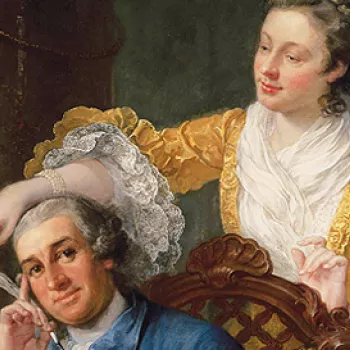George II (1683-1760) c.1727
Enamel with ivory backing | 7.5 x 5.9 cm (sight) | RCIN 421796

Christian Friedrich Zincke (1683/4-1767)
George II (1683-1760) c.1727


-
This miniature is adapted from Kneller's official portrait of George II dating from 1716 (RCIN 404389; Royal Collection). Kneller portrays the King full-length and wearing robes of State with the collar of the Garter. An earlier enamel copy by Zincke after the portrait by Kneller, also in the Royal Collection (421777) is signed and dated 1717. It seems likely, however, that this enamel was painted at about the time of the Coronation in 1727, when the derivations of Kneller's portrait and the engravings based upon it were revised in accordance with George II's accession to the throne.
The artist, Christian Frederick Zincke (1683/4-1767), was born in Dresden, the son of a goldsmith. He settled in England in 1706 and studied enamel painting under Charles Boit. He developed a thriving business, at first copying portraits by Sir Peter Lely and Sir Godfrey Kneller, then painting from life. He worked extensively for the royal family and, perhaps because he spoke German, was one of the few artists George II could tolerate. By 1730 he was well established at court and in February 1732, was appointed Cabinet Painter to Frederick, Prince of Wales, George II's eldest son. His eyesight began to fail, however, and he lamented: 'I find my Eyes scarce Capable of seeing them fine strokes'. By 1752 he had retired and only painted for his own pleasure. George II commented that Zincke's portraits were 'beautiful and like'. The technique of this enamel, with the clearly stippled flesh tones, is highly characteristic of Zincke as is the range of colour tones used to depict cheeks and lips. One of Zincke's great talents was the rendering of detail effectively, and the treatment of the complexities of the costume distinguishes this example from the work of contemporaries working in Zincke's manner.
George II, the only son of George I, was born at Herrenhausen in 1683. After the death of Queen Anne, the prince accompanied his father to Britain, but relations between them soon deteriorated. George I attempted to curtail the prince's allowance, and after his son's marriage to Caroline of Ansbach in 1705, to take custody of their children. When George II came to the throne, this feud was echoed in his relations with his own son, Frederick, Prince of Wales. After his accession, George II spent increasing lengths of time in Hanover. He eventually became drawn into its defence in 1741 and concluded a series of alliances which ultimately led to his notable victory over the French at the Battle of Dettingen in 1743. This restored his flagging popularity in Britain and his position was further strenghtened by his suppression of the Jacobite Rebellion in 1745.
Catalogue entry adapted from Masterpieces in Little: Portrait Miniatures from the Collection of Her Majesty The Queen (1992).Provenance
Probably in the Royal Collection since it was painted; probably seen by Walpole at Buckingham House in 1783; first certainly recorded in 1877
-
Creator(s)
-
Medium and techniques
Enamel with ivory backing
Measurements
7.5 x 5.9 cm (sight)
9.4 x 7.7 cm (frame, external)








